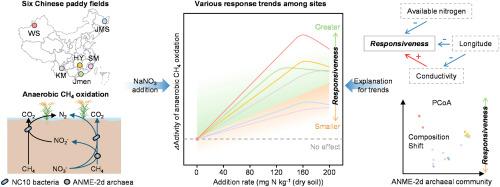中国稻田甲烷厌氧氧化对氮素添加的剂量响应模式
IF 10.3
1区 农林科学
Q1 SOIL SCIENCE
引用次数: 0
摘要
甲烷的厌氧氧化(AOM)已被确定为以前被忽视的稻田甲烷汇,并且已知氮输入会刺激甲烷的厌氧氧化。然而,在不同氮添加水平下AOM电位的响应模式以及最大化AOM的最佳氮添加水平方面,仍存在重要的知识空白。在此,我们研究了在0-200 mg N kg-1(添加量为40 mg N kg-1)的NaNO3条件下,中国6个稻田的AOM潜力。13CH4同位素实验量化的AOM电位随氮输入呈线性增加,在120 ~ 160 mg N kg-1达到峰值,之后刺激效应趋于平稳或下降。不同采样点的AOM电位响应不同,背景有效氮水平较低或电导率较高的采样点对氮添加的响应更大。此外,高通量测序和主坐标分析表明,ANME-2d古细菌群落组成在调节AOM对氮添加的响应方面比NC10细菌更突出。总体而言,本研究揭示了氮素添加对中国不同水稻土AOM电位的剂量依赖性刺激,强调了土壤无机氮有效性、电导率和ANME-2d古菌群落在塑造AOM响应中的关键作用。本文章由计算机程序翻译,如有差异,请以英文原文为准。

Dose-response patterns of anaerobic oxidation of methane to nitrogen addition in Chinese paddy fields
Anaerobic oxidation of methane (AOM) has been identified as a previously overlooked methane sink in paddy fields, and it is known to be stimulated by nitrogen inputs. However, important knowledge gaps remain regarding the response patterns of AOM potential to different levels of nitrogen addition, as well as the optimal nitrogen levels that maximize AOM. Here, we investigated AOM potential across six Chinese paddy fields under NaNO3 additions of 0-200 mg N kg-1 (with increments of 40 mg N kg-1). The AOM potential quantified by 13CH4 isotopic experiments was observed to increase linearly with nitrogen input, peaking at 120-160 mg N kg-1, after which the stimulatory effect plateaued or declined. AOM potential responses differed among sampling sites, and sites characterized by lower background available nitrogen levels or higher conductivity were more responsive to nitrogen addition. Furthermore, high-throughput sequencing and principal coordinates analysis revealed that the community composition of ANME-2d archaea played a more prominent role than that of NC10 bacteria in modulating AOM responses to nitrogen addition. Overall, this study revealed the dose-dependent stimulation of AOM potential by nitrogen addition in different Chinese paddy soils, highlighting the critical roles of soil inorganic nitrogen availability, conductivity, and the ANME-2d archaeal community in shaping AOM responses.
求助全文
通过发布文献求助,成功后即可免费获取论文全文。
去求助
来源期刊

Soil Biology & Biochemistry
农林科学-土壤科学
CiteScore
16.90
自引率
9.30%
发文量
312
审稿时长
49 days
期刊介绍:
Soil Biology & Biochemistry publishes original research articles of international significance focusing on biological processes in soil and their applications to soil and environmental quality. Major topics include the ecology and biochemical processes of soil organisms, their effects on the environment, and interactions with plants. The journal also welcomes state-of-the-art reviews and discussions on contemporary research in soil biology and biochemistry.
 求助内容:
求助内容: 应助结果提醒方式:
应助结果提醒方式:


